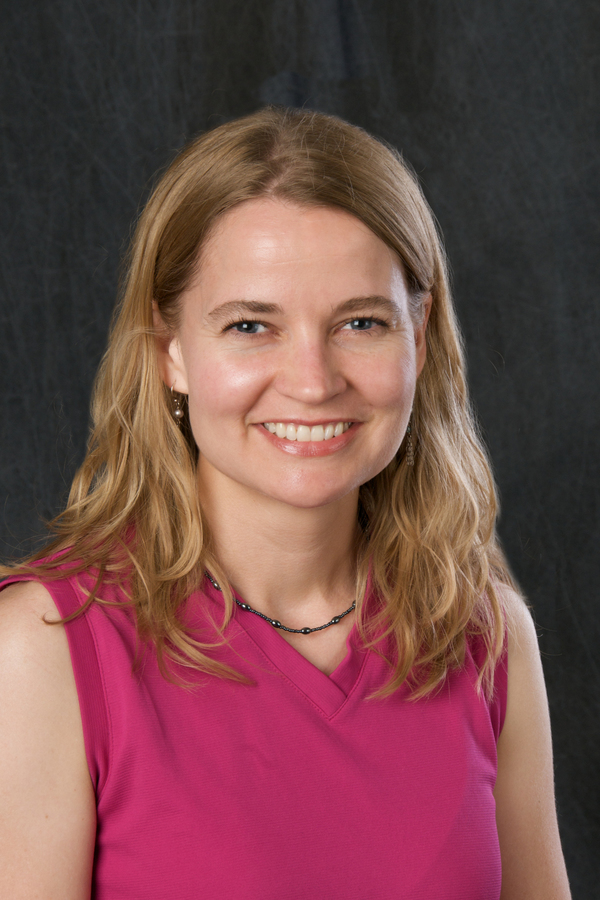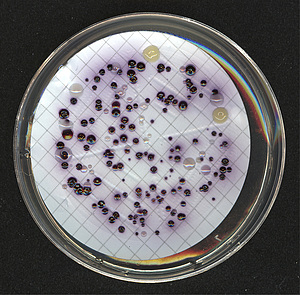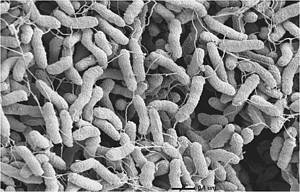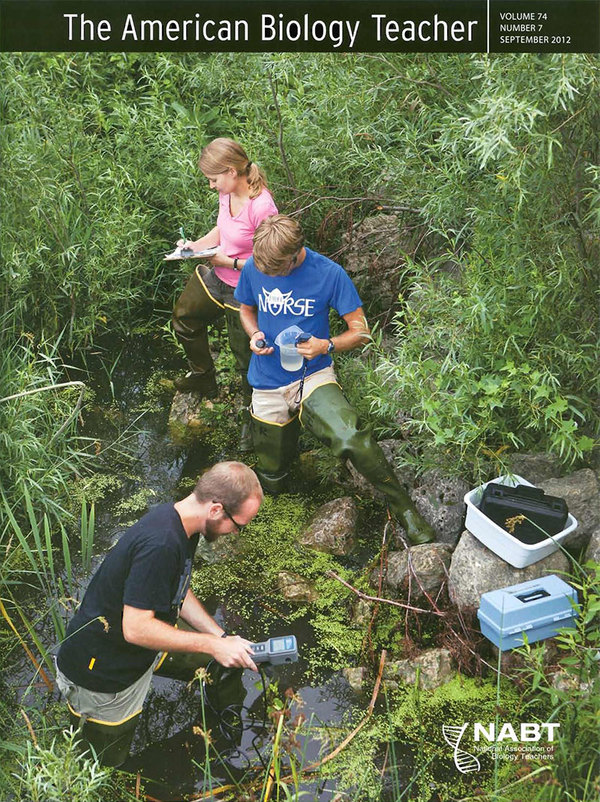Jodi Enos Berlage

About
Education: Ph.D., Bacteriology, University of Wisconsin-Madison; B.S., Microbiology, University of Illinois Urbana/Champaign
Jodi Enos-Berlage has been a professor in the biology department since the Fall of 2000. Her primary teaching responsibilities include Microbiology, Immunology, and Principles of Biology. She uses a variety of active learning strategies in the classroom and laboratory to engage students and enhance learning. As the coordinator for Biology department internships, Enos-Berlage facilitates and evaluates over 40 student internships/year in the health care, research, and environmental areas.
Enos-Berlage has strong interests in improving science communication for all audiences, and she has co-developed a seminar course focused on this subject. Enos-Berlage also collaborates with colleagues in the Luther Visual and Performing Arts Department, exploring opportunities for interdisciplinary work. In particular, Enos-Berlage is interested in combining science and the arts to more effectively express ideas.
Enos-Berlage maintains a dually-focused research program that actively involves undergraduate students. One area focuses on agricultural and urban water quality monitoring and land use. Local projects include both the agricultural and urban Dry Run Creek Watershed in Decorah. Enos-Berlage’s watershed work and participation and leadership in the annual Iowa Water Conference have resulted in a passion for attention to and care of our water resources. A second, longstanding research area that is also of high interest investigates how marine bacteria sense and respond to environmental signals. Specifically, Enos-Berlage is interested in how the bacterium Vibrio parahaemolyticus senses and responds to varying levels of metals in its environment by altering gene activity. Over 50 Luther undergraduate students have performed directed research projects with Enos-Berlage, resulting in over 40 research publications and presentations.
Enos-Berlage developed her interest in science and care for the natural world by growing up on a 300-acre beef farm in Northwestern Illinois. Together with her husband John, she owns and operates a small farm in the Dry Run Creek Watershed outside of Decorah.Their three children—Josephine, Jackson, and Justin—help raise cattle, pigs, chickens, and a large garden. Playing and running in the outdoors are favorite engagements. Enos-Berlage’s most treasured daily activity is reading out loud to her family after dinner each evening.
BIO 152 Principles of Biology: Molecules, Cells, and Genes
Cells serve as the building blocks of all biological systems, so understanding cellular biology is critical to comprehension of life systems. This course examines the structural and chemical composition of cells, processes related to cellular metabolism and homeostatic control, and genetic concepts related to protein formation, genetic replication and patterns of inheritance. Laboratory methods reinforce concepts and increase students’ ability to design experiments, analyze data, and communicate results in written form.
BIO 243 Microbiology
A basic introduction to the study of microorganisms and the principles of immunology and virology. Laboratory includes the study of basic cell processes and the identification and culturing of typical forms.
BIO 357 Immunology
This course examines how the cells and molecules of the human immune system develop and how they work together in providing defenses against invading microorganisms. A portion of the course will emphasize reading, evaluation, and presentation of primary and secondary immunological literature.
BIO 380 Internship
Registration in the following internships only by permission of the biology department and the cooperating institution. At least 40 interning hours are required for one credit, in a minimum of one 3-hour block of time per week during the semester. To earn study away credit during J-term, the internship must be full time for a minimum of three weeks. Students keep a journal and submit reflective essays and an academic paper to earn credit. BIO 380 credits do NOT apply toward the major. Prerequisites: BIO 151, 152, 12 hours in biology, and/or consent of instructor.
- Environmental biology internship. A work-study program in soils, conservation, forestry, fisheries, wildlife, or outdoor education. Field work to be completed in cooperation with conservation agencies, zoos, nature centers, and other environmental agencies.
- Health career internship. A work-study program in the various health professions in cooperation with area health care delivery institutions.
- Research internship. A work-study program at a major research institution or in an industrial setting. This would usually include participation in a specific research project.
SCI 340 Science Communication Seminar
This course examines the role of communication in math and science as well as the theory and practice of different types of science communication. The course will include observation, evaluation, and practice of oral and poster science presentations for different audiences, both general and scientific. Communication strategies for science educators will also be explored. Prerequisites: Consent of instructor. Intended for students participating in the Howard Hughes Medical Institute (HHMI) Trio program. Offered as credit/no credit.
B.S., Microbiology, Chemistry minor (1992) summa cum laude
- University of Illinois-Urbana/Champaign, Urbana/Champaign, IL
Ph.D., Bacteriology (1998) University of Wisconsin-Madison, Madison, WI
- Thesis: Characterization of thiamine-pyrophosphate synthesis independent of the PurF enzyme (phosphoribosylpyrophosphate amidotransferase) in Salmonella typhimurium
- Advisor: Diana Downs
Postdoctoral Research
Postdoctoral Research, Bacteriology (1998-1999), University of Wisconsin-Madison, Madison, WI
- Research project: Characterization of metabolic pathways involved in thiamine synthesis in Salmonella typhimurium
- Advisor: Diana Downs
Postdoctoral Research, Microbiology (1999-2000), University of Iowa, Iowa City, IA
- Research projects: (i) Characterization of opaque and translucent variants of Vibrio parahaemolyticus. (ii) Genetic and phenotypic characterization of bacterial biofilms in V. parahaemolyticus
- Advisor: Linda McCarter
Visiting Scholar in Microbiology, Sabbatical (2009) University of Iowa, Iowa City, IA
- Research projects: Identification of calcium-regulated genes in V. parahaemolyticus
Current Research Interests

Water Quality Research: Water quality and availability is of major importance locally, in the State of Iowa, and the world. We have been performing water quality research in a local watershed that is impaired for bacteria, specifically the Dry Run Creek Watershed. This 20,000-acre watershed drains into a common stream that enters the City of Decorah and subsequently empties in the Upper Iowa River. We have surveyed over 10 sites in the Dry Run Creek Watershed for multiple years, with the goal of identifying sites that are more prominent contributors of pollution. We assess a variety of field parameters, including temperature, pH, dissolved oxygen, conductivity (a measure of the number of charged molecules), and turbidity (a measure of water cloudiness). We also measure chemical and biological parameters, including nitrate, ammonia, total phosphorus, total nitrogen, chloride, E. coli (indicator of fecal pollution), and benthic macroinvertebrates (the ‘critters’ that dwell at the bottom of a stream). An urban water quality project in the City of Decorah examines many of these same parameters. Water quality data are evaluated in the context of associated land use, and research results are shared with area landowners and City officials in order to provide information for decision-making and implementation of practices to improve water quality. We also present this research at regional and national conferences, including the annual Iowa Water Conference.

Investigating how bacteria sense and respond to their environment: Microbes play tremendously important roles in the natural world, serving as major contributors to the base of the food chain and for recycling nutrients for all life. Understanding how bacteria both sense and respond to their environment is essential to understanding how they perform their important roles. Vibrio parahaemolyticus is a gram negative bacterium that can be found universally in ocean and estuarine waters. This organism is also a major human pathogen in areas of the world where raw seafood is consumed. Our current research seeks to understand how this organism senses and responds to various metals in the environment, including calcium, magnesium, and iron. We have uncovered a variety of bacterial cell processes, behaviors, and gene activities that respond to varying levels of these metals. Ultimately, we hope to use this information to better understand how this bacterium functions in marine, estuarine, and human host environments.
Research Presentations
R. Manges, K. Bies, K. Mahachi and J. Enos-Berlage. 2015. The effect of a calR mutation on Vibrio parahaemolyticus gene expression under varying calcium and iron conditions. National Conference on Undergraduate Research, Eastern Washington University, Cheney, WA.
Bies, Kelsey. 2014. Yeasty Beasties: How are Microorganisms Affected by their Environment? Iowa Council of Teachers of Mathematics-Iowa Science Teaching Section of the Iowa Academy of Science Conference. Ames, IA. (mentored this education major student for HHMI Trio program)
Bohr, L., J. Wittman, C. Dembsky, S. Zook, T. Nelson, and J. Enos-Berlage. 2014. Investigating water quality in the Dry Run Creek Watershed over seasons with varying precipitation. Iowa Water Conference, Ames IA.
Wittman, Jacob, and Jodi Enos-Berlage. 2013. Expanding opportunities and responsibilities in water resource education. Iowa Water Conference, Ames IA. Presentation awarded 1st place in Poster Competition.
Swanson, L., M. Thompson, E. Voelschow, L. Hieb, M. Cannon, A. Villard, J. Allen, A. Roos, L. McCarter, and J. Enos-Berlage. 2012. Calcium-regulated Gene Expression in Vibrio parahaemolyticus. Abstracts of the American Society for Microbiology General Meeting, San Francisco, CA. Abstract awarded ASM Student Travel Grant based on quality and significance of research.
Enos-Berlage, J. 2012. Involving Microbiology Students in a Watershed Project: Reconnecting Students with the Land. Abstracts of the American Society for Microbiology General Meeting, San Francisco, CA.
Wittman, J., A. Weckwerth, and J. Enos-Berlage. 2012. Exploring the Dry Run Creek Watershed: Molecules, Microbes, and Macroinvertebrates. Luther College Biology Colloquium Series, Decorah, IA. (Presentation also performed at the Luther College Annual Student Spring Research Symposium)
Voelschow, E., M. Thompson, L. Swanson, L. Hieb, M. Cannon, A. Villard, and J. Enos-Berlage. 2012. Investigating the Effects of Calcium and Iron on Gene Regulation in Vibrio parahaemolyticus. 25th National Conference on Undergraduate Research (NCUR), Ogden, UT. (Also presented at the Luther College Annual Student Spring Research Symposium)
Weckwerth, A., J. Wittman, S. Heyer, C. Weiss, J. Seibert, L. Seigley, C. Ingels, K. Larsen, and J. Enos-Berlage. 2012. Exploring the Dry Run Creek Watershed: Molecules, Microbes, and Macroinvertebrates. Iowa Water Conference, Ames IA. Presentation awarded 1st place in Poster Competition.
Weckwerth, A., J. Wittman, and J. L. Enos-Berlage. 2011. Investigating water quality in the Dry Run Creek Watershed. Biannual meeting of the Dry Run Creek Watershed Improvement Association, Decorah, IA.
Cannon, M. E., L. Hieb, and J.L. Enos-Berlage. 2011. Calcium controls gene activity in the bacterium Vibrio parahaemolyticus. Luther College Annual Student Research Symposium, Decorah, IA.
Siebert, J., C. Weiss, M. Cannon, L. Hieb, S. Heyer, K. Larsen, L. Seigley, and J.L. Enos-Berlage. 2011. Investigating water quality in the Dry Run Creek watershed. Luther College Annual Student Research Symposium, Decorah, IA.
Nelson, H. and J. L. Enos-Berlage. 2011. Characterization of mutants defective in calcium-regulated genes in Vibrio parahaemolyticus. R. J. McElroy Student/Faculty Research Symposium, Wartburg College, IA.
Schwan, W. R., R. Fitton, and J. L. Enos-Berlage. 2010. Loss of Surface Structures makes Uropathogenic Escherichia coli less Prone to Phagocytosis by Monocytes. American Society for Microbiology General Meeting, San Diego, CA
Voelschow, E. and J.L. Enos-Berlage. 2010. Investigating the fruit fly Drosophila melanogaster for use as a model host for Vibrio parahaemolyticus pathogenesis. Midstates Consortium for Math and Science Undergraduate Research Symposium in the Biological Sciences and Psychology, University of Chicago, Chicago, IL
Nelson, H. and J. L. Enos-Berlage. 2010. Phenotypic characterization of mutants exhibiting altered calcium regulation in Vibrio parahaemolyticus. 24th National Conference on Undergraduate Research (NCUR), University of Montana, Missoula, MT
Villard, A. C., L.L. McCarter, and J.L. Enos-Berlage. 2009. Investigating calcium-regulated gene expression in Vibrio parahaemolyticus. American Society for Microbiology North Central Branch Annual Meeting, La Crosse, WI. Presentation awarded 2nd place in Undergraduate Student Oral Competition.
Nelson, H. and J. L. Enos-Berlage. 2009. Phenotypic characterization of mutants exhibiting altered calcium regulation in Vibrio parahaemolyticus. American Society for Microbiology North Central Branch Annual Meeting, La Crosse, WI
Villard, A. C., L.L. McCarter, and J.L. Enos-Berlage. 2009. Investigating calcium-regulated gene expression in Vibrio parahaemolyticus. University of Iowa FUTURE in Biomedicine Research Symposium, Iowa City, IA
Marquardt, M., and J. L. Enos-Berlage. 2008. The effects of calcium on Vibrio parahaemolyticus secreted proteins. 22nd National Conference on Undergraduate Research, Salisbury University, Salisbury, Md.
Blackmore, J., and J. L. Enos-Berlage. 2008. Identification of Genes Involved in the Regulation of a Type III Secretion System in Vibrio parahaemolyticus. Luther College Senior Honors Convocation, Luther College, Decorah, IA
Holland, A. and J. L. Enos-Berlage. 2008. Mutagenesis and subsequent analysis of genes affecting calcium regulation in Vibrio parahaemolyticus. Luther College Senior Honors Convocation, Luther College, Decorah, IA
Lambrecht, J. A. and J. L. Enos-Berlage. 2007. Identification of Genes Involved in Calcium Regulation in Vibrio parahaemolyticus. Abstracts of the American Society for Microbiology General Meeting. Toronto, Canada
Marquardt, M. and J. L. Enos-Berlage. 2007. Colonial Cell Organization of Vibrio parahaemolyticus Under Varying Calcium Conditions in Wild Type and Mutant Strains. Abstracts of the R. J. McElroy Research Symposium. Wartburg College, IA.
Pontasch, H. and J. L. Enos-Berlage. 2006. Examination of the Effect of Calcium on Biofilm Development and Protein Expression in Vibrio parahaemolyticus. Abstracts of the National Council on Undergraduate Research General Meeting.
Lambrecht, J. A. and J. L. Enos-Berlage. 2006. Identification of Vibrio parahaemolyticus Genes Involved in Calcium Sensing and Response. Luther College Biology Colloquium Series. Decorah, IA.
A.P. Roos, J. R. Allen and J. L. Enos-Berlage. 2004. Identification of Calcium-Regulated Genes in Vibrio parahaemolyticus. American Society for Microbiology Regional Meeting-North Central Branch, Madison, WI.
Kelley, N. and J. L. Enos-Berlage. 2004. Investigating Vibrio parahaemolyticus Capsular Polysaccharide Levels in Response to Calcium. PEW Midstates Science and Mathematics Consortia Undergraduate Symposium, Chicago, IL.
Allen, J. R. and J. L. Enos-Berlage. 2004. Isolation and Characterization of Vibrio parahaemolyticus Mutants Defective in Calcium-Regulated Genes. American Society for Microbiology General Meeting, New Orleans, LA
Larson, J. M. and J. L. Enos-Berlage. 2004. Using Transmission Electron Microscopy to Investigate the Effect of Calcium on Vibrio parahaemolyticus. Howard Hughes Medical Institute Symposium for Undergraduate Research in Biology and Chemistry, Grinnel College, Grinnel, IA
Keenan, C. E., Christopherson, M. R., and J. L. Enos-Berlage. 2003. Initial characterization of a calcium-regulated gene in V. parahaemolyticus and isolation of mutants displaying altered regulation at this locus. American Society for Microbiology General Meeting, Washington, DC
Christopherson, M. R., Keenan, C. E., and J. L. Enos-Berlage. 2003. Investigation of Calcium-dependent regulation of gene expression in Vibrio parahaemolyticus. American Society for Microbiology General Meeting, Washington, DC
Christopherson, M. R., C. E. Keenan, and J. L. Enos-Berlage. 2003. Investigation of the role of calcium in bacteria. McElroy Student Research Symposium, Wartburg College, Waverly, IA
Enos-Berlage, J. L. 2003. Using primary literature to enhance learning in undergraduate microbiology courses. American Society for Microbiology General Meeting, Washington, DC
Keenan, C. Christopherson, M., and J. L. Enos-Berlage. 2002. Examination of opaque and translucent biofilms of Vibrio parahaemolyticus. American Society for Microbiology Regional Meeting—North Central Branch. Minneapolis, MN.
Jaeger, M. and J. L. Enos-Berlage. 2002. Investigation of the morphology of opaque and translucent phenotypes of Vibrio parahaemolyticus. PEW Undergraduate Science Research Symposium. Chicago, IL.
Christopherson, M., Keenan, C., and J. L. Enos-Berlage. 2002. Differential protein expression in response to calcium in Vibrio parahaemolyticus. PEW Undergraduate Science Research Symposium. Chicago, IL.
Howe, B. and J.L. Enos-Berlage. 2002. Investigating the effects of calcium on colony morphology in the marine bacterium Vibrio parahaemolyticus using electron microscopy. R.J. McElroy Student/Faculty Research Symposium. Wartburg College, Waverly, IA.
Keenan, C., Christopherson, M., and J.L. Enos-Berlage. 2002. Isolation and characterization of mutants having altered calcium regulation in Vibrio parahaemolyticus. Howard Hughes Medical Institute Symposium. Grinnell College, Grinnell, IA.
Sime, J. and J.L. Enos-Berlage. 2001. Investigating the role of calcium in bacterial physiology using Salmonella typhimurium as a model system. Undergraduate Research Symposium. St. Mary’s University, Winona, MN.
Enos-Berlage, J. L. and D. M. Downs. 1996. Mutations in sdh, encoding succinate dehydrogenase, alter the role of pantothenate in thiamine synthesis in Salmonella typhimurium. Abstracts of the General Meeting of the American Society for Microbiology, K157, p. 562
Enos-Berlage, J. L. and D. M. Downs. 1994. apbB, a new genetic locus which affects the alternative pyrimidine biosynthetic pathway in Salmonella typhimurium. Abstracts of the General Meeting of the American Society for Microbiology, K44, p. 283
Enos-Berlage, J. L. 2014. Bacteria in Iowa’s water: Risks, Sources, and Strategies. 7-9. In Deborah C. McDonough (ed.) Getting Into Soil and Water: 2014. Iowa Water Center, Ames, IA.
Wittman, J., A. Weckwerth, C. Weiss, S. Heyer, J. Seibert, B. Kuennen, C. Ingels, L. Seigley, K. Larsen, and J. Enos-Berlage. 2013. Evaluation of land use and water quality in an agricultural watershed in the United States indicates multiple sources of bacterial impairment. Environmental Monitoring and Assessment. 185: 10395-10420.
Rentschler, A. E., Lovrich, S. D., Fitton, R., Enos-Berlage, J., and W. R. Schwan. 2013. OmpR Regulation of the Uropathogenic Escherichia coli fimB Gene in an Acidic/High Osmolality Environment. Microbiology 159(Pt 2):316-27.
Enos-Berlage, J. L. 2012. Development of a Water-Quality Lab that Enhances Learning & Connects Students to the Land. American Biology Teacher. 74: 471-478. Associated photo was selected for issue cover.
Enos-Berlage, J. L., Z. T. Guvener, C. E. Keenan, and L. L. McCarter. 2005. Genetic determinants of biofilm development of opaque and translucent Vibrio parahaemolyticus. Mol Microbiol. 55:1160-1182.
Enos-Berlage, J. L. and L. L. McCarter. 2000. Relation of capsular polysaccharide synthesis and colonial cell organization to colony morphology in Vibrio parahaemolyticus. J. Bacteriol. 182:5513-5520.

ABT September 2012 Cover – Monitoring water quality in Dry Run Creek with students Jacob Wittman and Andrew Weckwerth.
Enos-Berlage, J. L. 2014. Bacteria in Iowa’s water: Risks, Sources, and Strategies. 7-9. In Deborah C. McDonough (ed.) Getting Into Soil and Water: 2014. Iowa Water Center, Ames, IA.
Wittman, J., A. Weckwerth, C. Weiss, S. Heyer, J. Seibert, B. Kuennen, C. Ingels, L. Seigley, K. Larsen, and J. Enos-Berlage. 2013. Evaluation of land use and water quality in an agricultural watershed in the United States indicates multiple sources of bacterial impairment. Environmental Monitoring and Assessment. 185: 10395-10420.
Rentschler, A. E., Lovrich, S. D., Fitton, R., Enos-Berlage, J., and W. R. Schwan. 2013. OmpR Regulation of the Uropathogenic Escherichia coli fimB Gene in an Acidic/High Osmolality Environment. Microbiology 159(Pt 2):316-27.
Enos-Berlage, J. L. 2012. Development of a Water-Quality Lab that Enhances Learning & Connects Students to the Land. American Biology Teacher. 74: 471-478. Associated photo was selected for issue cover.
Enos-Berlage, J. L., Z. T. Guvener, C. E. Keenan, and L. L. McCarter. 2005. Genetic determinants of biofilm development of opaque and translucent Vibrio parahaemolyticus. Mol Microbiol. 55:1160-1182.
Enos-Berlage, J. L. and L. L. McCarter. 2000. Relation of capsular polysaccharide synthesis and colonial cell organization to colony morphology in Vibrio parahaemolyticus. J. Bacteriol. 182:5513-5520.
Jodi Enos-Berlage co-developed this project with Jane Hawley, in collaboration with composer and music director Jon Ailabouni ’10 and cinematographer Ian Carstens ’14.
The Body of Water Project reveals the sacredness of water—this essential molecule and elixir of life—while acknowledging challenges and solutions surrounding water usage and quality on a local, regional, and global scale. Science and the arts are intentionally interwoven to more powerfully inform, connect, and inspire human bodies of water to cherish and protect this precious and damaged natural resource.
Inspiration for the Project
Body of Water is respectfully dedicated to the North American Indian nations, honoring their native land, practices, and reverence for the territory in which they lived. This project acknowledges water as a sentient life form, and this work as a prayer to return to a right relationship with the earth—recognizing that our own success is not dependent on our abilities to control or dominate, but on our ability to harmonize and see ourselves as a part.
In the life of the Indian there was only one inevitable duty—the duty of prayer—the daily recognition of the Unseen and Eternal. His daily devotions were more necessary to him than daily food. He wakes at daybreak, puts on his moccasins and steps down to the water’s edge. Here he throws handfuls of clear, cold water into his face, or plunges in bodily. After the bath, he stands erect before the advancing dawn, facing the sun as it dances upon the horizon, and offers his unspoken orison.
—Ohiyesa, the Santee Dakota physician and author, speaks in 1911 about the manner in which his people worship. Touch The Earth: A Self-Portrait of Indian Existence, compiled by T.C. McLuhan
Origin of Body of Water
The concept of Body of Water evolved during a series of teaching partnerships between dance professor Jane Hawley and biology professor Jodi Enos-Berlage. Enos-Berlage’s multi-year water quality research project on a local impaired stream, coupled with Hawley’s use of the body to generate a movement vocabulary for dance performance, provided the collaborative elixir for this production.
Performance Description
Body of Water is an original performance that intermixes dance, music and video components. Art and science are intentionally interwoven to create an end product more powerful than the sum of its parts–a compelling example of what can be accomplished with the liberal arts. While the videos tell the story of the essentialness of water, its geographic connectivity, its chemistry and biology, the major pollutants that impact both surface and groundwater, and potential solutions, the dancers and musicians produce complementary and novel movements that provide the basis for emotional and human connection. Hours were spent interviewing various stakeholders about water–this informed the performance, and portions of their visual and audio clips are included. The reverence that Native American populations have consistently and powerfully exhibited for this precious resource inspired the work.
Body of Water was originally performed at Luther College to multiple sold-out audiences in March 2015, and subsequently at the inaugural Grinnell Summer Arts Festival and at the C. Y. Stephens Auditorium, Iowa State University.
Read about the performance on the Des Moines Register website.
Body of Water Abstract
The key features of the water molecule justify its distinction as the molecule of life. Water allows cells to form and all bodies to survive. Flowing water authorizes movement and existence. Every cellular body exists in an ecosystem that is dependent on water flow, from backyards to streams, rivers, the Mighty Mississippi, Gulf of Mexico, ocean, and earth. This performance reveals the sacredness of water in an intimate way, creating affection and reverence for this essential molecule of life. Current challenges surrounding water usage and quality will be examined, along with solutions that involve practices and people within the Dry Run Creek Watershed, Decorah, and the broader community. This production highlights how small actions by individuals accumulate into a powerful force, producing an outcome that benefits all.
Download the Performance
The two-disc Body of Water DVD (or downloadable version) includes the full-length original 2015 performance at Luther College. Supplementary material on disc 2 includes a pre-performance video and nine shorter-length, narrated videos used during the performance and pre-performance.
All funds generated by these purchases (or donations) will be used to further our efforts in spreading the Body of Water message, including live performances at additional sites; additional research and efforts to merge the arts and sciences in productive ways, and interactive workshops for interested organizations, corporations, institutions, and communities; and other imagined exchanges created by you!
Purchase the downloadable version from the Luther Book Shop.